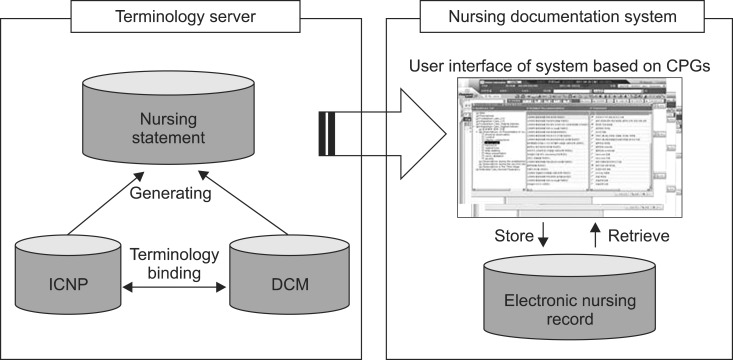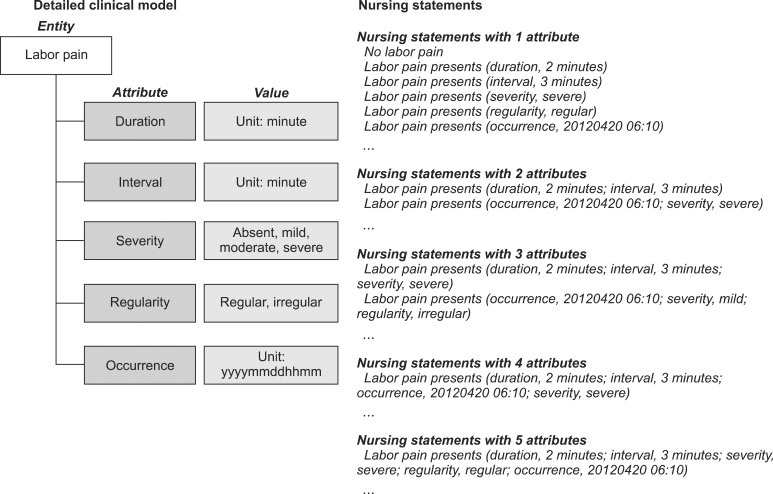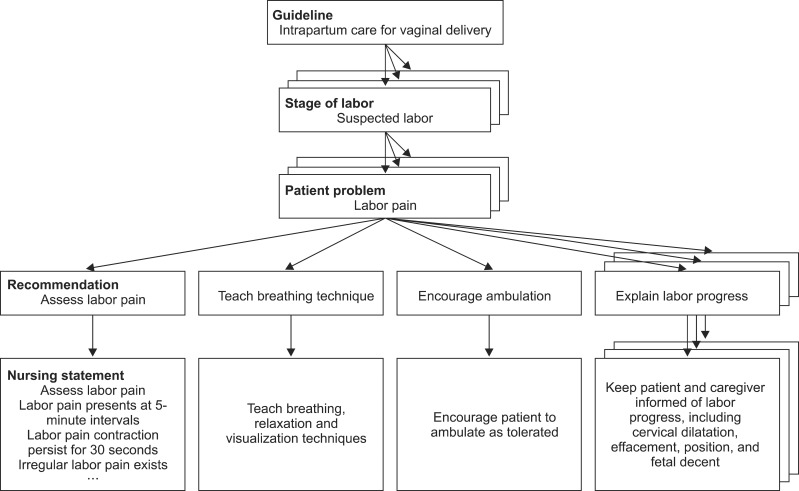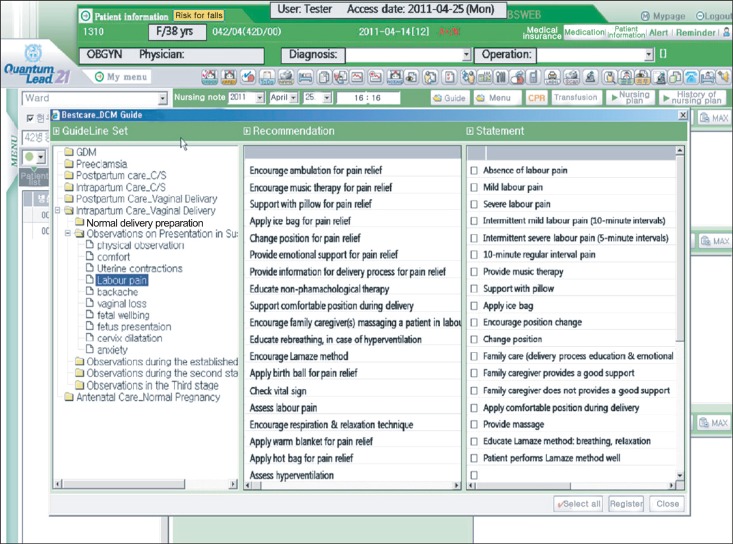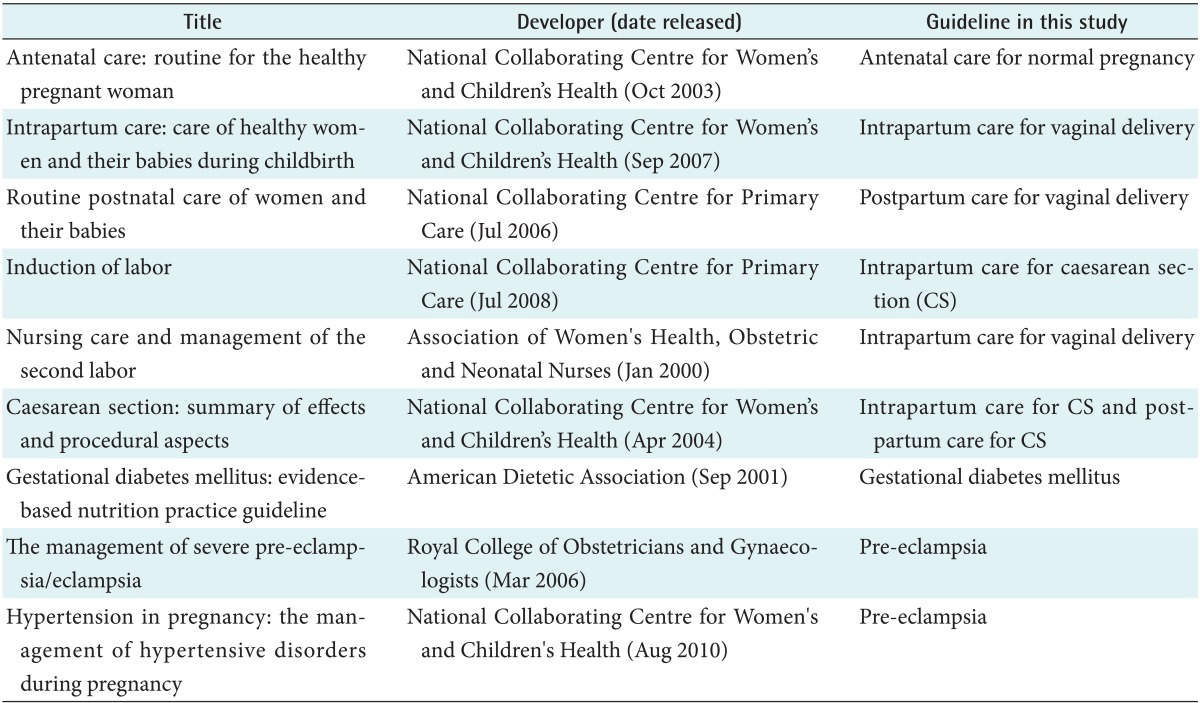 |
 |
- Search
| Healthc Inform Res > Volume 18(2); 2012 > Article |
Abstract
Objectives
The purpose of this study was to test the feasibility of an electronic nursing record system for perinatal care that is based on detailed clinical models and clinical practice guidelines in perinatal care.
Methods
This study was carried out in five phases: 1) generating nursing statements using detailed clinical models; 2) identifying the relevant evidence; 3) linking nursing statements with the evidence; 4) developing a prototype electronic nursing record system based on detailed clinical models and clinical practice guidelines; and 5) evaluating the prototype system.
Results
We first generated 799 nursing statements describing nursing assessments, diagnoses, interventions, and outcomes using entities, attributes, and value sets of detailed clinical models for perinatal care which we developed in a previous study. We then extracted 506 recommendations from nine clinical practice guidelines and created sets of nursing statements to be used for nursing documentation by grouping nursing statements according to these recommendations. Finally, we developed and evaluated a prototype electronic nursing record system that can provide nurses with recommendations for nursing practice and sets of nursing statements based on the recommendations for guiding nursing documentation.
The benefits of electronic nursing record (ENR) systems include reduced errors, improved quality of care, and lowered cost. These benefits can be maximized by using a standard nursing terminology, which improves data quality, data sharing, and decision support. In Korea, an ENR system based on standard nursing terminology was introduced for the first time at Seoul National University Bundang Hospital in 2003 [1]. For nursing documentation, nurses at Bundang Hospital use nursing statements that were created by combining concepts from the International Classification for Nursing Practice. The data gathered by this system have been used for decision-making and research [2,3].
However, the current system has some limitations in ensuring full semantic interoperability because nursing statements used for documentation have different levels of granularity with different qualifiers and value sets. The current ENR system also has not yet incorporated the available evidence on clinical practice guidelines (CPGs) and clinical pathways.
A data model is proposed to ensure the full semantic interoperability of a terminology-based ENR system. A data model expresses the classes of information required and the properties of those classes, including attributes, relationships, and states [4,5]. One such data model is a detailed clinical model (DCM) consisting of entity-attribute-value triplets. In a DCM, an entity is a core or focus concept of a data element. An attribute is a qualifier that represents a data entity in more detail. A value set represents a uniquely identifiable set of valid concept representations of an attribute.
There have been several different research projects to develop data models in health care for a national-level minimum data set, electronic health records, a decision support system, and data analysis. Examples are IMH Clinical Elements from Intermountain Healthcare, ISO 13606 Archetypes, Clinical Templates Scotland, Clinical Contents Models, Health Level 7 templates, and the DCM developed in the Netherlands [4-10].
However, the efforts in these approaches have been limited to the domain of medical knowledge. While the importance of developing a data model for nursing has been addressed by nurse informaticists [7], there is only one report on this topic in nursing literature by Goossen [11], other than research results published by the authors of this paper [12-16]. These research projects were only pilot studies which showed the possibility of model development in a limited nursing domain. Nursing statements generated using the entities, attributes, and value sets of the data models offer new possibilities to provide semantic interoperability for nursing records.
Limited use of evidence from research is one of the problems encountered in clinical practice. Translating research outcomes as evidence for clinical practice is necessary for ensuring patient safety and advancing the quality of healthcare. Evidence-based practice (EBP) is defined as a problem-solving approach to practice that involves the conscientious use of current best evidence in making decisions about patient care in order to promote the selection and implementation of the most appropriate intervention [17]. CPG with appraised summaries of research and recommendations for health care is one strategy with which to use the current best evidence [17,18]. As information technology is used to improve adherence to guidelines, there were several research projects integrating clinical guidelines or pathways into the clinical decision support system for pain, pressure ulcers, and obesity management in nursing [19-22].
However, these evidence-based clinical decision support systems were not linked to an ENR system. Therefore, nurses additionally have to document the nursing activities performed following recommendations. Thus, an ENR system linking EBP is proposed to solve these problems. An ENR system integrated with EBP not only guides nurses for best practice, but also helps them document nursing practice around best practice. To our knowledge, there has been no previous work on this topic.
Therefore, an ENR system based on DCMs and CPGs is proposed in this study. The purpose of this study is to test the feasibility of this system in perinatal care.
This study was carried out in five phases: 1) generating nursing statements using DCMs; 2) identifying the relevant evidence; 3) linking nursing statements with the evidence; 4) developing a prototype electronic nursing record system based on DCMs and CPGs; and 5) evaluating the prototype system (Figure 1).
We searched and reviewed published CPGs related to the assessment and management of perinatal care. The guidelines were searched for in the National Guideline Clearinghouse (www.guideline.gov), the Guidelines International Network (www.g-i-n.net), the New Zealand Guidelines Group (www.nzgg.org.nz), and the National Institute for Health and Clinical Excellence (NICE; www.nice.org.uk). The search terms used included 'labor,' 'pregnancy,' 'management of labor,' and 'delivery care.'
We extracted recommendations relevant to nursing care from these CPGs. These recommendations were rearranged by stage of labor and patient problems in each stage. We validated this arrangement internally by consulting three domain experts who were nurses with more than 10 years of clinical nursing experience in maternal care. Each recommendation was refined through repeated consultation with these domain experts.
We organized a set of nursing statements around the recommendations by referring to literatures such as textbooks on maternity and gynecologic care nursing, nursing interventions classification, and the North American Nursing Diagnosis Association (NANDA), Nursing Outcomes Classification (NOC), and Nursing Intervention Classification (NIC) linkage. For example, statements such as 'assess labor pain,' 'irregular labor pain,' and 'educate breathing, relaxation, and visualization techniques' were organized as part of the 'assess labor pain' recommendation.
A prototype ENR system based on DCMs and CPGs was developed and implemented on the Microsoft Window platform. ASP.NET, C#, WindowsSErver2008, .Net framework3.5, and Oracle 11 g were used for the design of the website and the implementation of the data storage and management system.
The ENR system consists of a terminology server managing International Classification for Nursing Practice (ICNP) concepts, DCMs, and nursing statements, and a nursing documentation system. The terminology server is used not only to manage the extended ICNP, the DCMs, and the nursing statements, but also the terminology binding of the DCM components to the ICNP concepts, and the generation of nursing statements. The nursing documentation system will be used by nurses to select a recommendation and appropriate nursing statements under the recommendation to create nursing records. Nurses can add values of attributes of the statements.
Twelve domain experts evaluated the prototype ENR system based on DCMs and CPGs. These domain experts were nurses with more than five years of clinical nursing experience in perinatal care at this hospital.
Before they evaluated the system, we presented the domain experts with nursing statements generated using DCMs, an organized set of nursing statements based on the recommendation, and then we demonstrated the developed system. Then, we asked domain experts to rate the completeness, relevancy, usefulness, and applicability of the recommendations using a questionnaire. In the questionnaire, experts were asked whether the recommendations were comprehensive enough for clinical practice, whether the recommendations were relevant enough to clinical practice, whether the recommendation were useful enough for expressing clinical practice, and whether the recommendations were applicable enough to clinical practice. The items of the questionnaire were scored on a five-point rating scale ranging from 'strongly disagree' to 'strongly agree.' We asked the experts to provide comments when they rated items with a score of 1 or 2.
Later, we interviewed each domain expert with open-ended questions on how easy the system was to use and how useful it was.
In total, 799 nursing statements for perinatal care were generated with the entities, attributes, and value sets of 90 DCMs such as 'labor pain,' 'vaginal discharge,' 'uterine contraction,' and 'fetal movement'. When generating nursing statements using DCMs, it is possible to generate nursing statements with different levels of granularity, different attributes and value sets. For example, the 'labor pain' DCM has five attributes, including interval, duration, regularity, severity, and occurrence. If we choose to generate a nursing statement with the duration and interval attributes, 'labor pain present (duration, 2 minutes; interval, 3 minutes)' is generated. If we choose to generate a nursing statement with all the attributes, 'labor pain present (duration, 2 minutes; interval, 3 minutes; severity, severe; regularity, regular; occurrence, 20120420 06:50)' is generated. More than 40 nursing statements with different levels of granularity can be generated using the 'labor pain' DCM, from a very simple nursing statement such as 'no labor pain' to a very complex statement such as 'labor pain present (duration, 2 minutes; interval, 3 minutes; severity, severe; regularity, regular; occurrence, 20120420 06:50)' (Figure 2).
We identified the following nine CPGs for different stages of labor, different types of delivery, and pregnancy risk levels: 'antenatal care for normal pregnancy,' 'intrapartum care for vaginal delivery,' 'postpartum care for vaginal delivery,' 'intrapartum care for caesarean section (CS),' 'postpartum care for CS,' 'pre-eclampsia,' and 'gestational diabetes mellitus' (Table 1). We extracted 919 recommendations from these nine CPGs. The number of recommendations for 'antenatal care for normal pregnancy,' 'intrapartum care for vaginal delivery,' 'postpartum care for vaginal delivery,' 'intrapartum care for CS,' 'postpartum care for CS,' 'pre-eclampsia,' and 'gestational diabetes mellitus' was 138, 244, 198, 30, 168, 110, and 31, respectively.
We extracted 506 unique recommendations related to nursing practice from the 919 recommendations and used them to create 506 sets of nursing statements. Figure 3 displays the structure of the 'intrapartum care for vaginal delivery' guideline. For example, 'suspected labor' is a category of Stage of Labor and 'labor pain' is a category of Patient Problem. Under 'labor pain' there are recommendations such as 'assess labor pain,' 'teach breathing technique,' 'encourage ambulation,' and 'explain labor process.' 'Labor pain presents at 5-minute intervals' is one of the nursing statements in the 'assess labor pain' set (Figure 3).
These 506 sets of nursing statements were implemented in the prototype ENR system based on DCMs and CPGs. The following are the linkages between nursing statements generated using the DCMs and the recommendations from the CPGs. For example, the nursing statement 'labor pain present at 5-minute intervals' was generated using the entity, attributes, and value sets of the 'labor pain' DCM. This nursing statement was used as one of the nursing statements for the 'assess labor pain' recommendation extracted from the 'intrapartum care for vaginal delivery' CPG.
Figure 4 shows the components of and relationship between the two components of the ENR system. The terminology server manages the ICNP concepts, DCMs, and nursing statements. The ICNP database (DB) contains ICNP concepts. The DCMs DB contains the entity, attribute, value set, optionality, data type, and mapping information of these entities, attributes, and value concepts to the ICNP concepts. The nursing statements DB contains the collection of nursing statements generated using the entities, attributes, and value sets of DCMs.
The prototype nursing documentation system displays the nursing statements arranged by recommendation for nurses to select in nursing documentation. The system developed in this study guides not only evidence-based nursing practice but also nursing documentation. Figure 5 shows a sample screenshot of the nursing records, displaying a list of nursing statements arranged by patient problem and recommendation.
The mean scores given for completeness, relevancy, usefulness, and applicability were 4.7, 4.7, 4.8, and 4.8 out of 5.0, respectively. Eight recommendations were rated as either 1 or 2. Five recommendations were rated as irrelevant and three recommendations as inapplicable. These recommendations were modified and refined. One example rated as irrelevant was the 'perform post-void residual catheterization' recommendation in the first stage of labor, because checking post-void residual urine is not necessary during the intrapartal care of a normal pregnancy. This was modified to 'assess urine including frequency and characteristics'. Another example rated as inapplicable was the recommendation 'instruct patient to report danger signs,' because observing any changes in fetal activity during delivery and reporting the danger signs to nurses might cause the patients discomfort. This was modified to 'instruct caregiver to report danger signs.'
The domain experts commented that the system was easy to use and useful in displaying sets of nursing statements after grouping them according to recommendation by stage of labor, type of delivery, and pregnancy risk level, and allowing nurses to search appropriate statements according to the care process. In addition, the new system user interface (UI) was not much different from that of the current ENR system. However, they pointed out that the statements were unnatural and that it took them too much time to select an appropriate value for each attribute. For example, a statement such as 'labor pain presents (interval, 5 minutes; duration, 1 minute)' does not have a natural sentence structure, and nurses need to pick values for the interval and duration attributes in order to document the labor pain completely.
This study is one of the first attempts to develop an ENR system based on data models and CPGs to support nursing practice and nursing documentation. The prototype system was found to be sufficiently complete, relevant, useful, and applicable in terms of content, and easy to use and useful in terms of the system UI. This study has revealed that developing such an ENR system is feasible.
The nursing statements describing patient problems vary more than nursing statements describing nursing interventions and nursing activities by the nursing units and disease types. Further, nursing statements describing the same patient status and problem have different levels of granularity with different qualifiers and value sets [23,24]. For example, the presence of pain or the intensity of pain is an important piece of information in one nursing unit, whereas the character of the pain, the quality of the pain, and the clinical course of the pain are more important in another nursing unit. For this reason, it is necessary to provide nursing statements with different levels of granularity with different qualifiers and value sets to nurses at the point of nursing documentation. It was possible for us to generate nursing statements with different levels of granularity in the prototype ENR system developed in this study. For example, 41 different nursing statements were generated using the 'labor pain' DCM.
In this study, the nursing statements were generated by combining the entity-attribute-value set triplets of DCMs to facilitate structured data entry. However, these statements were very structured and not natural to human language, and it took more time to select an appropriate value from a pick-list for each attribute than already pre-coordinated statements. To solve this problem, we refined these statements manually to mimic natural sentences, such as from 'labor pain (duration, 1 minute; interval, 5 minutes)' to 'labor pain presents for 1 minute at 5-minute intervals.' Therefore, a nursing statement generating system using natural language generation technology needs to be developed to automatically create more user-friendly, readable, and natural nursing statements in the future.
In this study, we used only published CPGs as clinical evidence. Although there is no lack of nursing-oriented guidelines [17,18], most of these guidelines are focused on chronic nursing care or specific nursing problems such as pain, pressure ulcers, and breast feeding. Nursing-oriented guidelines for acute care are still scarce. In order to develop a CPGs-based ENR system, relevant recommendations need to be extracted from various guidelines considering different target groups and context.
CPGs are promising tools for closing the gap between research and practice, yet the effective and timely implementation of evidence into practice remains fragmented and inconsistent [25,26]. One barrier is the limited integration of guidelines into the care process or the point of care. We categorized guidelines by stages of labor, different types of delivery, and pregnancy risk levels, and arranged and grouped recommendations according to the stages of labor and patient problems. Thus, recommendations provided in this prototype ENR system were more customized for different stages of labor and patient problems.
A CPGs-based ENR system will facilitate advanced nursing practice and the accumulation of key information generated during patient care. Therefore, individual patient data gathered with DCMs- and CPGs-based ENR systems will improve data quality, which in turn will provide a foundation for generating further evidence and measuring clinical outcomes.
However, this study has a few limitations. First, the implementation scope of CPGs was limited to perinatal care. Second, the evaluation of the ENR system was limited to the quality of its content by mainly limited domain experts. Therefore, further studies on the CPGs-based ENR system in other areas of nursing and evaluation of the system in terms of quality improvement in nursing documentation and nursing practice are recommended.
Acknowledgments
This research was supported by the Basic Science Research Program through the National Research Foundation of Korea (NRF) funded by the Ministry of Education, Science and Technology (No. 2010-0010468 & 2012-0000998).
References
1. Park HA, Cho I, Byeun N. Modeling a terminology-based electronic nursing record system: an object-oriented approach. Int J Med Inform 2007;76:735-746. PMID: 17018263.


2. Cho I, Park HA, Chung E. Exploring practice variation in preventive pressure-ulcer care using data from a clinical data repository. Int J Med Inform 2011;80:47-55. PMID: 21130682.


3. Park HA, Cho I, Chung E. Exploring use of a clinical data repository containing international classification for nursing practice-based nursing practice data. Comput Inform Nurs 2011;29:419-426. PMID: 20978438.


4. International Organization for Standardization. Health informatics: quality criteria and methodology for detailed clinical models. 2009. Geneva, Switzerland: International Organization for Standardization; (ISO/CEN/Working Draft 13972)

5. Coyle JF, Mori AR, Huff SM. Standards for detailed clinical models as the basis for medical data exchange and decision support. Int J Med Inform 2003;69:157-174. PMID: 12810120.


6. Beale T. Archetypes: constraint-based domain models for future-proof information systems. Proceedings of the 11th OOPSLA Workshop on Behavioral Semantics 2002;p. 16-32.

7. Hovenga E, Garde S, Heard S. Nursing constraint models for electronic health records: a vision for domain knowledge governance. Int J Med Inform 2005;74:886-898. PMID: 16115795.


8. Garde S, Hovenga E, Buck J, Knaup P. Expressing clinical data sets with openEHR archetypes: a solid basis for ubiquitous computing. Int J Med Inform 2007;76(Suppl 3):S334-S341. PMID: 17392019.


9. Ahn SJ, Kim Y, Yun JH, Ryu SH, Cho KH, Kim SW, Kwak MS, Yu SJ, Koh YT, Choi DJ. Clinical contents model to ensure semantic interoperability of clinical information. J KIISE Softw Appl 2010;37:871-881.

10. Goossen W, Goossen-Baremans A, van der Zel M. Detailed clinical models: a review. Healthc Inform Res 2010;16:201-214. PMID: 21818440.



11. Goossen WT. Using detailed clinical models to bridge the gap between clinicians and HIT. Stud Health Technol Inform 2008;141:3-10. PMID: 18953119.


12. Kim Y, Park HA. Development and validation of detailed clinical models for nursing problems in perinatal care. App Clin Inform 2011;2:225-239.

13. Park HA, Min YH, Kim Y, Lee MK, Lee Y. Development of detailed clinical models for nursing assessments and nursing interventions. Healthc Inform Res 2011;17:244-252. PMID: 22259726.



14. Min YH, Park HA. Development and validation of archetypes for nursing problems in breast cancer patients. J Korean Soc Med Inform 2009;15:393-401.

15. Lee MK, Park HA. Development of data models for nursing assessment of cancer survivors using concept analysis. Healthc Inform Res 2011;17:38-50. PMID: 21818456.



16. Kim YR, Park HA, Min YH, Lee MK, Lee YJ. Development of detailed clinical models of nursing information for initial assessment. J Korean Acad Fundam Nurs 2011;17:101-112.

17. Coopey M, Nix MP, Clancy CM. Translating research into evidence-based nursing practice and evaluating effectiveness. J Nurs Care Qual 2006;21:195-202. PMID: 16816597.


18. Davies B, Edwards N, Ploeg J, Virani T. Insights about the process and impact of implementing nursing guidelines on delivery of care in hospitals and community settings. BMC Health Serv Res 2008;8:29PMID: 18241349.



19. Im EO, Chee W. Evaluation of the decision support computer program for cancer pain management. Oncol Nurs Forum 2006;33:977-982. PMID: 16955125.


20. Chang SO, Lim SH, Lee SJ, Kim MS. Development of a decision support computer program for pain management in institutionalized patients with dementia. Korean J Fundam Nurs 2011;18:116-129.

21. Lee NJ, Bakken S. Development of a prototype personal digital assistant-decision support system for the management of adult obesity. Int J Med Inform 2007;76(Suppl 2):S281-S292. PMID: 17606400.


22. Kim HY, Park HA. Development and evaluation of data entry templates based on the entity-attribute-value model for clinical decision support of pressure ulcer wound management. Int J Med Inform 2012;81:485-492. PMID: 22079242.


23. Kim EM, Park IS, Shin HJ, Ahn TS, Kim YA, Oh PJ, Woo KS, Jeong EH, Joo YH, Cho EM, Yu OS. The analysis of standard nursing statements at electronic nursing records. J Korean Clin Nurs Res 2005;11:149-164.

24. Lee I, Park HA. Comparison of nursing records of open heart surgery patients before and after implementation of electronic nursing record. J Korean Soc Med Inform 2009;15:83-91.

25. Grol R, Grimshaw J. From best evidence to best practice: effective implementation of change in patient's care. Lancet 2003;362:1225-1230. PMID: 14568747.


26. Ploeg J, Davies B, Edwards N, Gifford W, Miller PE. Factors influencing best-practice guideline implementation: lessons learned from administrators, nursing staff, and project leaders. Worldviews Evid Based Nurs 2007;4:210-219. PMID: 18076464.


Figure 1
Development phase of an electronic nursing record system based on detailed clinical models and clinical practice guidelines. ICNP: the International Classification for Nursing Practice.

Figure 4
Elements of the electronic nursing record system based on detailed clinical models and clinical practice guidelines. ICNP: the International Classification for Nursing Practice. DCM: detailed clinical models.
